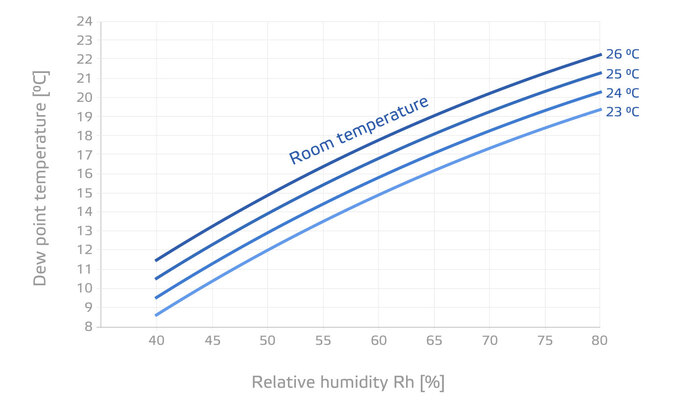What is dew point temperature?
The dew point is another way to describe how much moisture is present in the air. It is the temperature at which condensation starts. In other words, at the dew point temperature, the air becomes fully saturated with moisture, and condensation begins to form on surfaces with that specific temperature or lower. The dew point depends on both air temperature and relative humidity.
What is air saturation?
The amount of water vapour air can hold depends on temperature. When temperature rises, relative humidity decreases, and when temperature falls, relative humidity increases. Once relative humidity reaches 100%, the air is saturated and cannot absorb additional moisture. This does not mean that a space is filled with water; it simply indicates that further moisture will condense.
A higher dew point means that the air is more humid. Indoors, relative humidity is largely influenced by everyday activities such as cooking, showering, drying clothes, and even normal respiration. These activities release moisture into the air while the indoor temperature often remains stable.
For optimal comfort and building protection, it is recommended to keep the indoor dew point below 15—16 °C. In practical terms, measuring the dew point helps indicate whether indoor air is overly humid. A rising dew point signals that the air is holding a high amount of moisture. This can cause moisture to condense on cool surfaces like windows, walls or air ducts, potentially leading to dampness, mould, wood rot, peeling finishes, and overall poor indoor air quality. Individuals may also experience increased respiratory complaints or joint discomfort.
The chart below provides an indicative overview of dew point temperatures:

What is the importance of ventilation?
To prevent condensation and maintain a healthy indoor environment, excess moisture must be removed. Effective ventilation is essential for controlling humidity and protecting building materials as well as the comfort and well-being of the occupants.
Humidity levels vary between rooms. Kitchens and bathrooms typically have higher humidity and therefore require adequate ventilation. Measuring the dew point provides a practical indication of moisture levels. A rising dew point signals that humidity is accumulating and that dehumidification or increased ventilation may be necessary.
In mechanically cooled buildings, controlling the dew point is a more effective way for preventing moisture problems than controlling relative humidity alone. Microbial growth such as mould does not start just because the relative humidity of the air is high, but when water vapour condenses on a surface or is absorbed into materials (such as insulation, carpets, wood). The dew point tells us exactly when condensation will occur. A dew point limit of 15 °C is recommended in mechanically cooled buildings, since few surfaces are cooled that low in buildings.
A lower indoor dew point of 13 °C would further reduce risk, but also significantly increase energy consumption. A limit of 15 °C therefore provides a more affordable balance between reducing energy consumption and reducing occupant health risks.
Sentera developed a wide range of temperature and humidity sensors. Typical applications are humid spaces like bathrooms and kitchens, but also wine cellars, changing rooms, swimming pools etc. Since both temperature and humidity are such determinant factors for our well-being, also our CO2 and VOC sensors measure these values.
